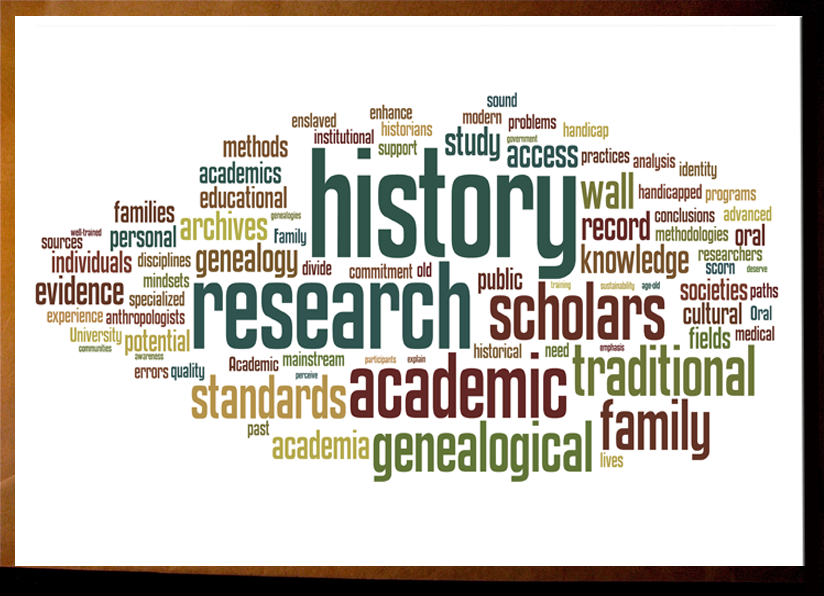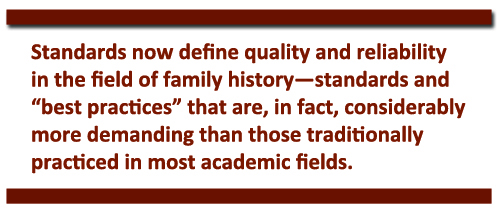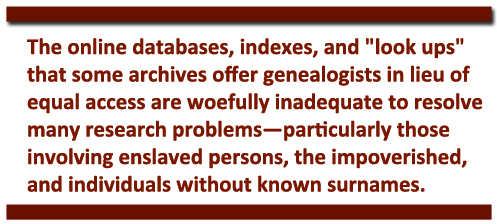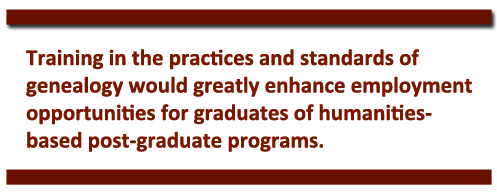
Yes. Seriously. From Boston University to Brigham Young, and across the waters to the UK’s Strathclyde, Dundee, and Open University—as well as many lesser-known institutions in between. A century-old wall is crumbling between academia and family history. Should we be concerned? Or should we embrace the possibilities?
Oral history has a long tradition of acceptance in the academic world. Family history has a much more checkered past. Good reasons exist for the status of both, but it is long since time for outmoded assumptions to be reconsidered.1 Here at Evidence Explained—a forum and a manual that serves both sides of the traditional divide—we see many ways that each can help the other and too many ways that old mindsets still handicap us all.
Past Perspectives
In many cultures studied by anthropologists, cultural demographers, historians, and other humanists, oral history has been the only kind available. Populations in which individuals could not write would have no historical voice if oral accounts and traditions were not accepted.
That said, in all societies across the eons, oral accounts have notoriously exaggerated the status of individual families, romanticized ancestors, and glossed over the rougher edges of the social group. Their counterparts in literate societies, published genealogies, have been testable against documentary evidence and their flaws have been easy to expose. More damning for genealogy, the traditional emphasis on minute personal details has come at the expense of meaningful context—the examination of individual lives within the framework of a broader history.
Because objectivity is a basic tenet of scholarship, the uncritical and preening nature of many works of genealogy—generically called family histories—have earned the scorn of those who seriously study the human experience. Narrowly focused genealogies have occasionally served as reference works for academics needing to quickly identify some minor participant in a significant event. Otherwise, only a few disciplines have been open to genealogical perspectives and only within a limited framework—as when anthropologists need to evaluate the self-image of a cultural group under study.2
Unfortunately, these academic users have also handicapped themselves. Individual and institutional unfamiliarity with the standards that exist in modern genealogy—indeed, the traditional assumption that family history has no standards at all—leads many time-pressured academics to indiscriminately accept any genealogical work that easily fills their needs. Too often, they miss vitally important works in peer-reviewed genealogical journals simply because, as some candidly admit, “genealogical journals aren’t among those normally consulted in my field.” There is a consequence. Using unreliable sources creates unreliable work, regardless of the interpretative skills of the scholar.3

Modern Changes
The late-20th century saw a seismic change in the practice of genealogy, chiefly in five areas: education, record access, research methodology, evidence analysis, and quality-control standards:
- A rise of educational venues, primarily outside the academic mainstream, has greatly increased public knowledge of record sources, their quality, and their usage.4
- Sophisticated research methodologies have been developed by which researchers can produce scholarly work on the micro level, even in subject areas previously considered impossible—especially with the reconstitution of enslaved, impoverished, and no-surname families.5
- Corporations, family-history societies, and governmental archives have widely disseminated original source material via film and digital images, enabling even hobbyists to conduct research of professional depth and breadth.
- Original records, interdisciplinary context, and analytical correlations have become requisites for sound conclusions.6
- Standards now define quality and reliability in the field of family history—standards and “best practices” that are, in fact, considerably more demanding than those traditionally practiced in most academic fields.7

Fractured Coexistence
Progress notwithstanding, the age-old breech has not been sealed between those who toil in history’s diverse fields. Today, that breech is not so much a divide as it is a firewall—one that handicaps us all. From the perspective of one who has straddled that wall for decades, I see three factions with distinctive mindsets:
- Students and scholars in the academic setting still scorn those they perceive as untrained and unreliable. This perception exists, primarily, because the wall that has protected their own standards for more than a century has also shielded them from exposure to the discipline that has emerged on the other side of the wall. (Ironically, in these academic ranks we often find genealogical hobbyists who, to protect their professional standing, pursue their research covertly, outside the mainstream of both fields. An unfortunate result of their isolation, too often, is the production of work that fails today’s rigorous standards for reliable family histories.)
- Genealogists who seriously study individuals, families, and communities—microhistorians by nature—also scoff at errors put into print by macroscholars whose conclusions about the "bigger issues" of society rest upon flawed assertions about issues of hearth and home, kinship networks, and personal identities. Their complaints deserve to be taken seriously within academia. Even well-meaning errors, once put into print, compound themselves and warp the lenses through which all humanistic fields interpret our world.
- Hobbyists still represent the most visible face of genealogy in the public mind. That’s understandable. Curiosity about the past attracts millions whose busy lives allow only snatches of time to satisfy their curiosity. New social-networking sites lure many who want the experience of connecting to others and love the graphic concept of “trees” whose entwining branches could link the world. Neophytes are excited to see or hear they may be kin to Madonna, Chris Rock, or President Whoever. While all these interests are dismissed in academia as “history lite,” they are indirectly valuable to institutional scholarship. The public support all these millions give to history are critical to the survival of archives amid incessant financial crises and they incubate a steady supply of new students for the humanities in an era when many university administrators question the need for such.
In short: the professionalization of family history and its development as a discipline outside of traditional educational venues still remains unrecognized in too much of the academic mainstream. The limited interaction between the two educational paths and the limited awareness among traditional scholars of the rigors of modern family history still severely hamstring both sides of the divide.

Prospects for Cooperation
As a field of study, genealogy offers tremendous potential to support other humanistic disciplines. Anthropology, archaeology, cultural geography, demography, history, and sociology all labor to explain social and political events that cannot be fully understood without accurately identifying the participants and knowing the personal relationships between them.
Academic researchers, however, face a serious handicap in their pursuit of this type of knowledge. Resolving problems of identity and relationship requires an intense commitment of time and specialized expertise in methods and sources. Those skills are still rarely taught within the academic system; and the time commitment is one that few academic scholars can make, given the publish-or-perish pressure of their professions.
Conversely, genealogical scholars remain handicapped by archival restrictions that deny them access allowed to other scholars. The online databases, indexes, and "look up" services that some archives offer in lieu of equal access are woefully inadequate to resolve many research problems—particularly those involving enslaved persons, the impoverished, and individuals without known surnames. The presumption existing in some archives—that genealogical or biographical research is a matter of looking up a name—is regularly disproved by genealogical scholars who apply advanced research strategies and analytical methods.8 They can only do so, however, when given access to the needed records that are open to other scholars.
Beyond traditional academic research, training in the practices and standards of genealogy would greatly enhance employment opportunities for graduates of humanities-based post-graduate programs. Skilled professionals—well-trained in research methodology, with diagnostic-level knowledge of the nature and legal underpinnings of myriad record types, a sound understanding of how to apply genetics to historical research to prove identities and kinships, and solid grounding in evidence analysis—are regularly engaged by U.S. courts and legal firms, archaeological and medical research projects, and government agencies charged with identifying and repatriating the remains of military personnel. The interdisciplinary research methodologies developed by the genealogical discipline would valuably enhance traditional academic programs.

The Bottom Line
Significant potential exists for academics, genealogical scholars, and family historians to assist each other toward their common goals. Will we develop that potential? Or will we persist in plodding the separate paths that limit and diminish the quality of work done by all?
Sources
1. For perspectives on this issue across the past half-century, see
- Edward N. Saveth, “The Problem of American Family History,” American Quarterly 21, Supplement (Summer 1969): 311–29.
- Samuel P. Hays, “History and Genealogy: Patterns of Change and Prospects for Cooperation,” Prologue: The Journal of the National Archives 7 (Spring 1975): 39–43, (Summer 1975): 81–84, and (Fall 1975): 187–91.
- Elizabeth Shown Mills, “Academia vs. Genealogy: Prospects for Reconciliation and Progress,” National Genealogical Society Quarterly (Winter 1983): 162–70; archived online at Historic Pathways (http://www.historicpathways.com/download/acadvgenea.pdf).
- Richard J. Cox, “Genealogy and Public History: New Genealogical Guides and Their Implications for Public Historians,” Public Historian 6 (Spring 1984): 89–96.
- Christopher D. Barth, “Archivists, Genealogists, Access, and Automation” (http://www.arcticwind.com/cdb/writings/archives1.shtml : dated 8 May 1997), particularly the section “Where Do We Go from Here?”
- Elizabeth Shown Mills, “Genealogy in the ‘Information Age’: History’s New Frontier?” Centennial address, National Genealogical Society, May 2003, expanded for publication, NGS Quarterly 91 (December 2003): 260–77; archived online at Historic Pathways (http://www.historicpathways.com/download/genininfoage.pdf).
- Thomas W. Jones, “Post-Secondary Study of Genealogy: Curriculum and Its Contexts,” Avotaynu: The International Review of Jewish Genealogy 23 (Fall 2007): 17–23; originally presented at the September 2007 symposium of the International Institute for Jewish Genealogy (an agency of the National Library of Israel, Givat Ram Campus, Hebrew University of Jerusalem); a draft of the original paper is archived online at IIJG’s website (https://www.avotaynuonline.com/2007/10/postsecondary-study-of-genealogy-curriculum-and-its-contexts-by-thomas-w-jones-phd-cg-cgl-fasg/).
- Elizabeth Shown Mills, “Bridging the Historic Divide: Family History and ‘Academic’ History,” History and Genealogy: Why Not Both? Papers from the Midwestern Roots Conference, published by Indiana University Department of History, Indiana Magazine of History: Online Resources (https://www.historicpathways.com/download/bridghisdivideivide.pdf).
- Jack Temple Kirby, “ANCESTRYdotBOMB: Genealogy, Genomics, Mischief, Mystery, and Southern Family Stories,” Journal of Southern History 76 (3–38); the Southern Historical Association’s annual presidential address. Kirby's paper reflects a common mindset among traditional historians who are "closet genealogists." Being isolated from the genealogical mainstream left him unaware of the existence of a genealogical discipline and uncomfortably derisive in his attempt to defend his "hobby" to fellow academics.
- Daniel Wagner, ed., Selected Lectures on Genealogy: An Introduction to Scientific Tools (Jerusalem: IIJG, 2013).
2. For example see Virginia Dominguez, White by Definition: Social Classification in Creole Louisiana (New Brunswick, N.J.: Rutgers University Press, 1993).
3. For examples of this class of problem perpetuated in academic literature, corrected by the application of genealogical research standards, and published in peer-reviewed journals, see
- George Ely Russell, “Molly Welsh: Alleged Grandmother of Benjamin Banneker,” National Genealogical Quarterly 94 (December 2006): 305–14.
- Elizabeth Shown Mills, “Demythicizing History: Marie Thérèse Coincoin, Tourism, and the National Historic Landmarks Program,” Louisiana History 53 (Fall 2012): 402–37; archived at Historic Pathways (http://www.historicpathways.com/download/Demythicizing-LHfall12-ocr.pdf).
4. Among the venues available outside traditional academia, the annual conferences of the National Genealogical Society and the Federation of Genealogical Societies, each, offer 100–200 hours of intermediate and advanced instruction in historical sources and research methodology by leading genealogical scholars and professionals. The U.S. National Archives has, for more than a half-century, hosted a summer institute, the National Institute for Genealogical Research, designed for advanced study of federally created manuscripts. Formal academic programs include those of Boston University’s Center for Professional Education (http://professional.bu.edu/programs/genealogy/), a program ACE-credited for 3 graduate-level semester hours and transferable to other accredited institutions, and Brigham Young University’s Center for Family History and Genealogy (https://history.byu.edu/), which offers both degree and certificate programs. Other educational venues are outlined at Board for Certification of Genealogists (https://bcgcertification.org/learning/education/), under the “Educational Preparation” tab.
5. The leading sources of this instruction have been the Institute of Genealogy and Historical Research, based for decades at Samford University but now at the University of Georgia (http://www.ighr.gagensociety.org/), which pioneered Advanced Methodology for historical researchers in the 1980s and has trained many academics; the National Genealogical Society Quarterly (http://www.ngsgenealogy.org/cs/ngsq), which specializes in instructive case studies; and the Salt Lake Institute of Genealogy (https://ugagenealogy.org/aem.php?eid=36) developed by associates of Salt Lake’s Family History Library. More recent programs include the Forensic Genealogy Institute of the Council for the Advancement of Forensic Genealogists (http://www.forensicgenealogists.org/forensic-genealogy-institute.html) and the Genealogical Research Institute of Pittsburgh (http://www.gripitt.org/).
6. For convenient but informal introductions to the interdisciplinary nature of modern genealogy, see the blogs The Legal Genealogist and The Genetic Genealogist.
7. Genealogy’s standards have been codified by the Board for Certification of Genealogists, which has led the evolution of standards since its creation in 1964. Its latest edition is Genealogy Standards: Fiftieth Anniversary Edition (Nashville, Tenn.: Turner Publishing, 2014). For a textbook approach to standards and practices of evidence analysis, see Thomas W. Jones, Mastering Genealogical Proof (Arlington, Va.: National Genealogical Society, 2014). The standard textbooks for the practice of genealogy are the two manuals edited by Elizabeth Shown Mills: Professional Genealogy: Preparation, Practice & Standards (Baltimore: Genealogical Publishing Co., 2018), whose 26 chapters are authored by 22 leading professionals, and its predecessor Professional Genealogy: A Manual for Researchers, Writers, Editors, Lecturers, and Librarians (Baltimore: Genealogical Publishing Co., 2001), whose 29 chapters were authored by an entirely different team of experts.
8. The case studies published by the National Genealogical Society Quarterly regularly demonstrate this point. For that reason—particularly their value in reconstructing the lives and families of slaves—NGSQ articles since the 1990s are frequently included in “catalogs of recent scholarship” published by academic history journals. For representative examples of those case studies, see
- Daniela Moneta, “Virginia Pughs and North Carolina Wests: A Genetic Link from Slavery in Kentucky,” NGSQ 97 (September 2009): 179–94; demonstrates the integration of genetic testing with the documentary criteria of the Genealogical Proof Standard to resolve identity problems among the enslaved.
- Dawn C. Stricklin, “Namesakes, Name Changes, and Conflicting Evidence: The Search for the Mother of John Little Crow,” NGSQ 94 (December 2006): 245–58; demonstrates the resolution of Native-American identity problems caused by tribal naming customs.
- Rachal Mills Lennon and Elizabeth Shown Mills, “Mother, Thy Name Is Mystery! Finding the Slave Who Bore Philomene Daurat,” Reconstructing Female Lives: A Special Issue of the National Genealogical Society Quarterly 88 (September 2000): 201–24; demonstrates the reconstruction of a slave family across three generations of matriarchal households; archived at Historic Pathways (http://www.historicpathways.com/download/philodurat.pdf).
How to Cite This Lesson
Elizabeth Shown Mills, “QuickLesson 18: Genealogy? In the Academic World?” Seriously? Evidence Explained: Historical Analysis, Citation & Source Usage (https://www.evidenceexplained.com/content/quicklesson-18-genealogy-academic-world-seriously : posted 9 January 2014).